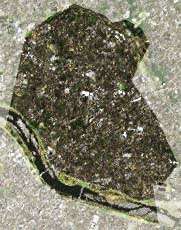Komae, Tokyo
Komae (狛江市, Komae-shi) is a city located in the western portion of Tokyo Metropolis, Japan. It is one of 30 municipalities in the western portion of Tokyo known as the Tama Area. As of 1 February 2016, the city had an estimated population of 80,464, and a population density of 12,000 persons per km². Its total area is 6.39 square kilometres (2.47 sq mi). It is the smallest administrative city in Tokyo Meotropolis both in area and population, and the second smallest in terms of area in the nation.
Komae 狛江市 | |
|---|---|
 Komae City Hall | |
 Flag  Seal | |
 Location of Komae in Tokyo | |
 Komae | |
| Coordinates: 35°38′5.2″N 139°34′43.3″E | |
| Country | Japan |
| Region | Kantō |
| Prefecture | Tokyo |
| Government | |
| • Mayor | Kunihiko Takahashi (since July 2012) |
| Area | |
| • Total | 6.39 km2 (2.47 sq mi) |
| Population (February 2016) | |
| • Total | 81,671 |
| • Density | 12,780/km2 (33,100/sq mi) |
| Time zone | UTC+9 (Japan Standard Time) |
| Symbols | |
| • Tree | Ginkgo biloba |
| • Flower | Azalea |
| Phone number | 03-3430-1111 |
| Address | 1-1-5 Izumi-Honcho, Komae-shi, Tokyo 201-8585 |
| Website | www |
Geography

Komae is nestled between the Tama River to the southwest, and the much smaller Nogawa river to the north and east which flows near its boundaries with Chōfu city and Setagaya Ward. It is mostly flat. It is a small municipality; its boundaries fit within a circle of 2 km radius centred on the city hall. It is essentially a residential suburb of Tokyo which urbanised rapidly in the 1960s and 1970s, with most of the working population commuting to central Tokyo. There are several neighbourhood shopping areas, mainly around the train stations. The City Hall is located near Komae Station.
Surrounding municipalities
- Tokyo Metropolis
- Setagaya-ku
- Chofu
- Kanagawa Prefecture
History
The city's name is thought to originate from the word koma, referring to migrants, especially Goguryeo from the Korean peninsula who settled here around the 5th century AD.[1][2][3] Numerous kofun burial mounds are located within the city borders.
The area of present-day Komae was part of ancient Musashi Province. In the post-Meiji Restoration cadastral reform of July 22, 1878, the area became part of Minamiitama District in Kanagawa Prefecture. The town of Itsukaichi was created on April 1, 1889 with the establishment of municipalities law. Minamtama District was transferred to the administrative control of Tokyo Metropolis on April 1, 1893. Odakyu Railways's Odawara line was constructed through Komae in 1926, linking it with Shinjuku in central Tokyo. Expanding population led to Komae being upgraded to the status of a town in 1952, and to a city on October 1, 1970.
On September 1, 1970, Tama River's levee failed during a typhoon, and 19 houses were destroyed by torrential flooding. The riverbanks have now been strengthened. A small memorial stands at the location of the levee failure.
Politics and government
Komae is run by a city assembly of 22 elected members. The current mayor is Kunihiko Takahashi, an independent heading a coalition of the Democratic Party of Japan with the Liberal Democratic Party of Japan and the Komeito, which ousted long-term Japanese Communist Party mayor Yutaka Yano in 2012
Education
Komae has six public elementary schools and four public middle schools opened by the city. The one public high school, Komae High School, is operated by the Tokyo Metropolitan Government Board of Education.
Transportation
Railway
(Some areas in the north of the city have better access to Keiō Line stations in neighbouring Chōfu city.)
Highway
- Komae is not served by any national highways or expressways.
Local attractions
Annual events in Komae include a raft-race on Tama River every July, and a city fair in mid-November.
The town has a group of festival mascots called Komarangers; their purpose is to cheer up the citizens of the town. They come in five colors: red, blue, green, yellow, and pink.
Notable people from Komae
- Sadao Araki - Army general and pre-war rightwing politician
- Sumire Haruno - Takarazuka actress
References
- Sumiko Enbutsu; Mimi LeBourgeois (April 2000). "Tokyo Water Walks". Tokyo On Foot hosted by Tokyoq. Archived from the original on 2011-10-05. Retrieved 2008-11-11.
The city name, Komae, probably derived from "Koma," a word referring to Kogyo of ancient Korea, probable origin of the immigrants.
External link in|publisher=(help) - "Archived copy" 東京都狛江市歴史探訪 (in Japanese). Archived from the original on 2011-06-15. Retrieved 2008-11-11.
狛江の名前の由来> 古来、高麗人が日本の関東地方に帰化しましたが、狛江の地にも人々が渡来しました。このことから、地名の由来は「高麗(コマ)」に由来しているといわれています。
CS1 maint: archived copy as title (link) - Ayako Shinomiya Burton (November 1994). "Japanese Language Planning in Korea 1905-1945" (PDF). Simon Fraser University. pp. 11p.
particularly around the 5th century, as many Koreans technically skilled in such areas as architecture, ceramics, weaving and iron casting camed to and settled in Japan. Korean cultrual words such as fude (writing brush), tefu (notebook), and even place names such as Koma, Komae and Rebonri, and the most prominent, Nara ("country" in Korea), were introduced into Japan around that time.
External links

- Komae City Official Website (in Japanese)